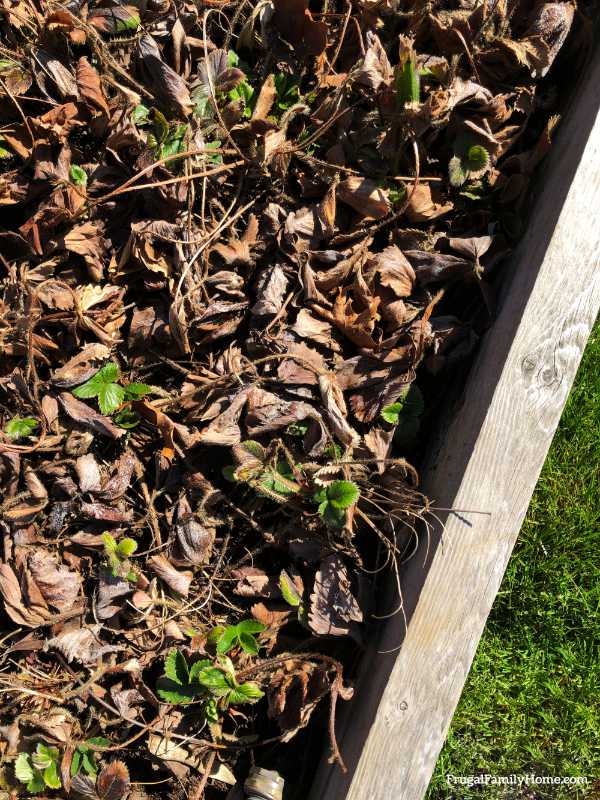To care for strawberry plants in spring, ensure they receive ample sunlight, regular watering, proper soil drainage, and protection from pests. Strawberry plants require specific care during the spring season to ensure healthy growth and a bountiful harvest.
Adequate sunlight is crucial for the plants to thrive, so choose a sunny location for planting. Regular watering is essential, but ensure the soil has proper drainage to avoid waterlogging the roots. Protecting the plants from pests, such as slugs or birds, is also necessary.
By following these tips, you can provide the ideal conditions for your strawberry plants to flourish and enjoy the delicious fruits they produce.

Credit: frugalfamilyhome.com
How to Care for Strawberry Plants in Spring in 6 Easy Steps
1. Choosing And Preparing The Right Spot For Planting
Choosing the right spot for planting strawberry plants in spring is crucial. It’s important to select a sunny location with well-drained soil to ensure their healthy growth. Before planting, clear the area of any weeds and debris to reduce competition.
Additionally, amending the soil with organic matter can greatly improve its fertility, providing the plants with essential nutrients. By following these guidelines, you can create an optimal environment for your strawberry plants to thrive and produce a bountiful harvest in the spring season.
2. Planting Strawberry Plants
Purchase healthy, disease-free strawberry plants and dig proper holes for spacing. Place the plants in the holes and cover their roots with soil for optimal growth. By following these steps, you can ensure the health and success of your strawberry plants in spring.
3. Providing Adequate Water And Nutrients
Strawberry plants in spring require adequate water and nutrients for optimal care. Regular watering is essential to keep the soil moist without over-saturating it. To retain moisture and suppress weeds, it’s recommended to mulch around the plants. This also helps in maintaining healthy plant growth.
Additionally, fertilizing the strawberry plants with a balanced strawberry fertilizer is crucial. The fertilizer provides the necessary nutrients for robust plant development and high-quality fruit production. By following these steps, you can ensure that your strawberry plants receive the care they need during the spring season to thrive and yield a bountiful harvest.
Maintain a consistent watering schedule, apply mulch, and provide adequate nutrients to enjoy healthy and delicious strawberries from your garden.
4. Managing Pest And Disease Issues
Monitor your strawberry plants for common pests like aphids, slugs, and snails. Take action using organic pest control methods such as handpicking or using insecticidal soap. Additionally, identify and treat any common strawberry diseases like powdery mildew or gray mold promptly.
Proper monitoring and treatment will ensure the health and productivity of your strawberry plants throughout the spring season. Keep a close eye on your plants, removing any pests or diseases as soon as they are detected. By doing so, you can protect the quality and quantity of your strawberry harvest.
Maintain a proactive approach to pest and disease management to maximize the success of your strawberry plants in the spring months.
5. Pruning And Training Strawberry Plants
To care for strawberry plants in spring, it is important to prune and train them properly. Start by removing any dead or damaged leaves and runners. This will help keep the plants healthy and prevent the spread of diseases. Additionally, thin out crowded plants to improve air circulation, which will reduce the risk of fungal infections.
Training the plants to grow vertically using trellises or stakes is also beneficial. This allows more sunlight to reach the leaves and helps keep the fruits off the ground, reducing the risk of rotting. By following these guidelines, you can ensure that your strawberry plants thrive and produce a bountiful harvest in the spring season.
6. Harvesting And Enjoying Strawberries
Harvesting and enjoying strawberries is an exciting part of caring for strawberry plants in spring. Before picking the berries, it’s important to wait for them to fully ripen. When harvesting, gently pluck the strawberries, making sure to leave the green cap attached.
These fresh strawberries can be enjoyed immediately, whether eaten on their own or used in delicious recipes. If you have an abundance of strawberries, preserving them for later use is a great option. You can freeze them, make jams or even create homemade strawberry preserves.
By following these guidelines, you can fully savor the fruits of your labor and enjoy the delicious taste of ripe strawberries throughout the spring season.
Frequently Asked Questions Of How To Care For Strawberry Plants In Spring
How Often Should I Water Strawberry Plants In Spring?
In spring, it’s important to water strawberry plants regularly to keep the soil moist but not waterlogged. Aim to provide about 1 inch of water per week, either through rainfall or irrigation. Be careful not to overwater, as this can lead to root rot and other issues.
Do Strawberry Plants Need Sunlight In Spring?
Yes, strawberry plants need plenty of sunlight in spring to thrive and produce healthy fruits. They should be placed in a location that receives at least 6 to 8 hours of direct sunlight per day. If your garden doesn’t get enough sun, consider using grow lights or planting in containers that can be moved to sunnier spots.
When Should I Fertilize Strawberry Plants In Spring?
To promote healthy growth and fruit production, fertilize strawberry plants in spring when new leaves appear. Use a balanced organic fertilizer and apply it according to the package instructions. It’s important not to over-fertilize, as this can lead to excessive foliage growth at the expense of fruit production.
Can I Plant Strawberries In Spring?
Yes, spring is a great time to plant strawberries. Choose a sunny location with well-draining soil and prepare the bed by removing any weeds and amending the soil with compost or aged manure. Space the plants about 12 to 18 inches apart and water thoroughly after planting.
Should I Prune Strawberry Plants In Spring?
Yes, pruning strawberry plants in spring is important to promote healthy growth and encourage fruiting. Remove any dead or damaged leaves, as well as runners that are crowding the main plant. This allows air and sunlight to penetrate the plant, reducing the risk of disease and improving fruit quality.
Conclusion
To sum up, caring for strawberry plants in spring is critical for a bountiful harvest. By following the right techniques, such as proper watering, removing weeds, providing ample sunlight, and protecting the plants from pests, you can ensure the health and productivity of your strawberry plants.
Remember to regularly monitor the moisture levels, as overwatering or underwatering can affect the plants’ growth. Additionally, be diligent in removing any weeds that may compete for nutrients and space. Shielding the plants from pests, using natural repellents or covering them with netting, will help safeguard the strawberries.
Incorporate organic fertilizers and mulching to nourish the soil and maintain its moisture level. With these essential strategies in place, you can enjoy juicy and flavorful strawberries all season long. Happy gardening!

